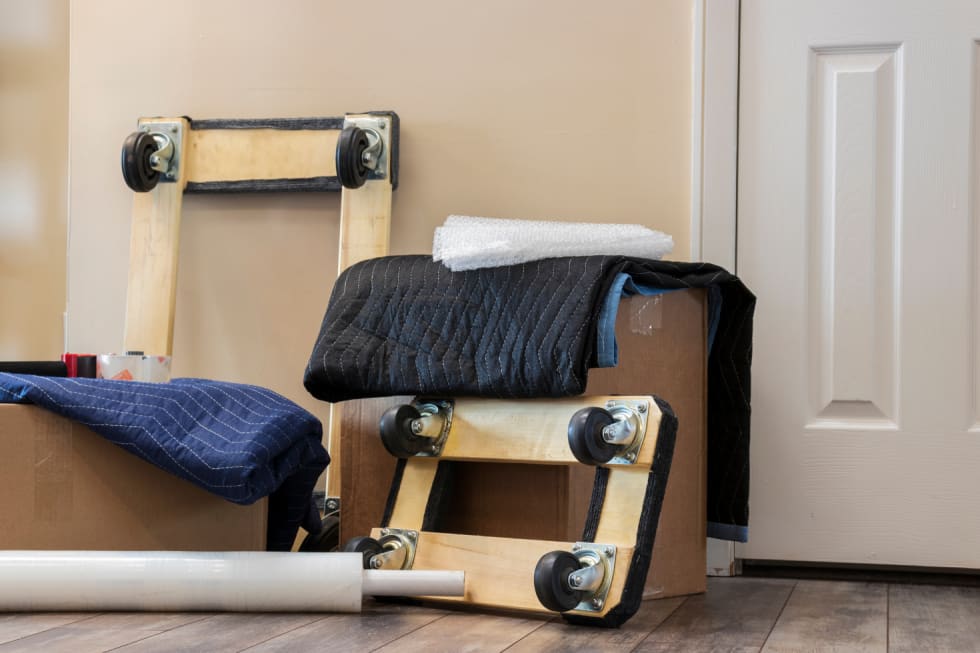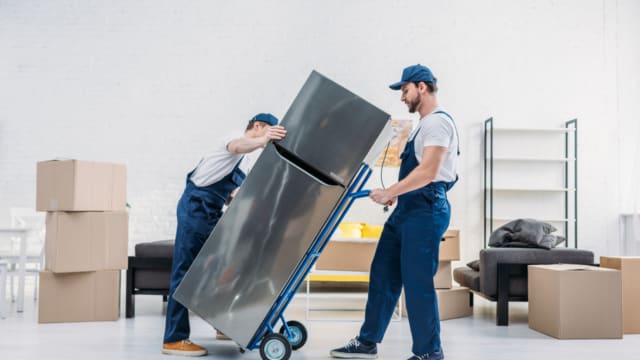Where to Get Moving Boxes: The Ultimate Moving Guide
Introduction
Feeling overwhelmed about your upcoming apartment move? We’ve got you covered. In the labyrinth of tasks that is moving, finding the right moving boxes can often feel like a quest in itself.
Luckily, we’re here to guide you through the ins and outs of finding the right boxes to make sure you’re equipped for a smooth move. Come dive in with us as we explore all there is to know about finding the best moving boxes for your furnishings and your wallet.
Where Can I Find Free Moving Boxes?
Want to embark on your apartment move without breaking the bank? You’re in luck! There’s endless options right under your nose. From liquor stores to your local Costco, and from the bustling pages of Craigslist to the community vibes of Facebook Marketplace, free moving boxes are just waiting to be claimed.
Eco-Friendly Finds: Liquor stores are gold mines for sturdy boxes perfect for your heavier items. Pharmacies, bookstores, and grocery stores receive shipments regularly and are usually more than happy to hand over the boxes that would otherwise be recycled. Big-box stores like Costco are also in the mix, often having a pile of boxes up for grabs post-shipment.
The Power of Local Platforms: Craigslist and Facebook Marketplace are bustling online communities where you can find just about anything, including moving boxes. These platforms not only make it easy to locate free boxes within your vicinity but also highlight the environmental perks of reusing materials.
Securing Your Treasures: Finding these boxes may require a bit of legwork and timing. A pro tip? Call ahead or visit these places shortly after a shipment has arrived for the best selection. Local coffee shops, U-Haul Box Exchange, and recycling centers are also excellent sources. Don’t forget to tap into your neighborhood via the Nextdoor app or by simply asking around. Sometimes, the best resources are closer than you think.
Types of Boxes and Their Uses

Not all boxes are created equal. Each type of box has its unique role in ensuring your treasures make it safely to your new abode. Let’s look at the different kinds of boxes, their specific uses, and how they can make your move smoother.
Book Boxes: These are the Hercules of moving boxes. Compact but sturdy, they’re designed to handle the weight of your literary collection, documents, and similarly heavy items. But don’t let their name limit their potential - they’re also perfect for safely packing away your collection of vinyl records or your heavy kitchen gadgets.
Linen Boxes: Think of these as the gentle giants. Larger and slightly less sturdy than book boxes, they’re ideal for packing bedding, towels, clothes, and other lightweight but bulky items. Their size makes them versatile, but be cautious not to overpack them, as their structural integrity could be compromised.
China Boxes: These are the guardians of your fragile items. Double-walled for extra protection, china boxes are designed to transport your dishes, glassware, and other breakables. They often come with dividers and insulation to provide additional safety during the move.
Purchasing Moving Boxes: Retail Options
While the allure of free moving boxes is strong, sometimes the hunt can turn into more of a chore than a treasure quest. That’s when purchasing new moving boxes becomes a viable option.
Where to Buy New Moving Boxes
- Home Depot & Lowe’s: These home improvement giants are the go-to spots for new moving boxes. They offer a wide range of sizes and types, from book boxes to wardrobe boxes.
- Office Supply Stores: Stores like Staples and Office Depot also stock moving supplies, including boxes. They’re a good bet for finding smaller sizes perfect for office supplies or documents.
- Moving Companies: If you’re hiring a moving company, ask about purchasing boxes directly from them. They often offer specialized boxes for items like TVs or artwork.
Pros and Cons
Pros:
- Quality and Durability: New boxes are sturdy and reliable, reducing the risk of breakages during the move.
- Variety: You have access to a wide range of sizes and types, ensuring you get the perfect box for every item.
- Convenience: Buying boxes can be quicker and less hassle than hunting down free options. Plus, you can often order online and have them delivered to your doorstep.
Cons:
- Cost: The biggest con is the cost. While not exorbitantly expensive, purchasing boxes can add up, especially for a large move.
- Environmental Impact: Buying new boxes isn’t the most eco-friendly option. However, you can mitigate this by choosing recycled boxes and ensuring you recycle them after the move.
Cost-Benefit Analysis
When deciding whether to buy or find free boxes, consider both the monetary and time investment. If you’re short on time or moving last-minute, purchasing boxes may be worth the cost for the convenience and peace of mind. However, if you’re on a tight budget and have the time to source free boxes, that route might be more appealing.
Essential Moving Supplies Beyond Boxes

While boxes play a pivotal role in any move, they’re just the tip of the moving iceberg. To ensure a seamless transition from one apartment to another, you’ll need a handful of other supplies.
Packing Tape: To secure your boxes and ensure they stay closed during the move, you’ll need packing tape. Look for high-quality, durable packing tape that won’t give up halfway through loading the truck, such as Scotch Heavy Duty Shipping Packaging Tape.
Bubble Wrap: For your fragile items, bubble wrap is a must-have. It cushions your valuables, providing a protective bubble barrier against bumps and drops.
Markers: Don’t underestimate the power of a good marker. Labeling your boxes not only helps with organization but also saves you a mountain of headache when unpacking.
Checklist of Essential Moving Supplies:
- Packing Tape: To secure your boxes and keep them closed during the move.
- Bubble Wrap: To protect fragile items from damage.
- Markers: To label boxes for easy identification and organization.
- Packing Paper: For wrapping and cushioning items to prevent scratches.
- Stretch Wrap: To secure drawers and doors on furniture.
- Box Cutter: For easily opening boxes upon arrival.
- Furniture Pads: To protect furniture and floors during the move.
- Rope or Straps: To secure items in the moving truck.
- Tape Measure With a tape measure in hand, you can ensure your larger items will fit snugly in your moving vehicle.
Remember, while the hunt for boxes is a crucial part of your moving prep, these additional supplies are just as important for ensuring a smooth move.
Check out our guide to moving a fridge safely!
After the Move: What to Do With Your Boxes

Once the dust settles and the last box is unpacked, you might find yourself in a cardboard fortress wondering, “What now?” Before you send your faithful boxes to the curb, let’s explore some creative and sustainable ways to give them a second life.
Get Crafty with Cardboard: Transform those moving boxes into a playhouse for your kids or pets. With a bit of imagination and some craft supplies, you can create anything from a rocket ship to a medieval castle. Not only does this provide hours of entertainment, but it also encourages creativity and recycling.
Organize Your Space: Cut the boxes into drawer dividers or storage bins. Cover them with fabric or wrapping paper to create a custom look that matches your decor. It’s an affordable way to keep your drawers tidy and your belongings organized.
Garden with Cardboard: Use flattened boxes as a weed barrier in your garden. Cardboard is biodegradable and blocks sunlight, preventing weeds from taking over your garden beds. It’s a win-win for you and the environment.
Donate to Local Organizations: Many schools, daycares, and animal shelters are in constant need of cardboard for projects and bedding. By donating your boxes, you’re not only clearing out clutter but also supporting your community.
Recycle Responsibly: If you’ve exhausted all possibilities, recycling is the next best step. However, remember to remove any tape and labels as these can contaminate the recycling process. Check with your local recycling center for specific guidelines.
By choosing to reuse, repurpose, or recycle your moving boxes, you’re making a positive impact on the environment. Each box that gets a second life is one less in the landfill.
Packing Tips for an Efficient Move
Packing might not be the highlight of moving, but with the right strategies, it can be far from the chore it’s often made out to be. Here are some expert packing tips that promise to streamline your move and make unpacking a breeze.
Labeling is Key: A marker will be your best friend during the packing process. Label each box with its contents and the room it’s destined for in your new apartment. This simple step can save you hours of hunting for items when you’re settling in. For a tech-savvy approach, consider using QR codes that link to a list of the box’s contents.
Pack by Room: Tackle one room at a time to keep things organized. This method not only makes packing less overwhelming but also simplifies the unpacking process. Plus, it prevents items from different rooms from getting mixed up.
The Right Materials: Invest in quality packing materials. Sturdy boxes, reliable packing tape, and plenty of cushioning materials like bubble wrap or packing paper can prevent damage during the move.
Heavier Items on the Bottom: When packing a box, start with the heavier items on the bottom and lighter items on top. This helps prevent damage and makes the boxes easier to move.
Utilize Suitcases and Baskets: For an eco-friendly move, use suitcases, baskets, and even drawers as packing containers. They’re perfect for transporting clothes, linens, and even books, and they reduce the number of boxes needed.
Vacuum Seal Bags: Use vacuum seal bags for bedding, towels, and clothing. They drastically reduce the volume of these bulky items, making them easier to transport.
Protect Fragile Items: Wrap breakables in bubble wrap or packing paper and secure them with tape. For extra protection, pack these items in double-walled boxes and fill any empty spaces with additional cushioning material.
Conclusion
Now that you know where to find the best moving boxes to protect your belongings, it’s time to secure the perfect place to unpack them.
Our AI-powered apartment-finding platform streamlines your search for an ideal rental by matching you with properties that fit your unique preferences and lifestyle needs. Whether you’re moving across town or relocating to a new city, we make it easy to find a place you’ll love to call home. Take the stress out of apartment hunting and start your search with us today. Find your perfect match and get ready to make your next move.




